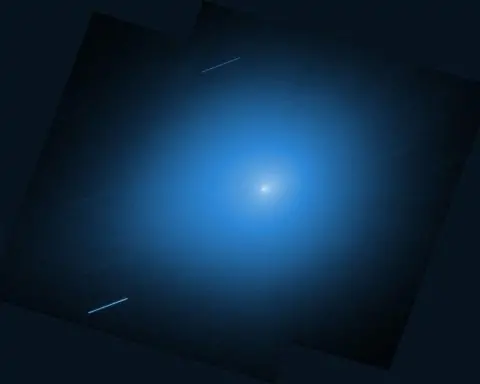- 3I/ATLAS, an interstellar comet, was detected on July 1, 2025, possibly 10 km across, and is the third known interstellar visitor after ʻOumuamua (2017) and Borisov (2019). <li NASA’s Parker Solar Probe captured the closest-ever images of the Sun’s corona and solar wind from 3.8 million miles away during a December 24, 2024 flyby. <li The first isolated rogue black hole, estimated at 6–7 solar masses, was confirmed in Sagittarius with evidence from Hubble (2011–2022) and Gaia data. <li A early July 2025 European heatwave caused about 2,300 heat-related deaths across 12 cities in 10 days, with roughly 1,500 deaths attributable to human-caused climate change. <li Researchers proposed fluorine-free PFAS substitutes, including bulky tree-branch molecules with carbon–silicon backbones that matched PFAS surfactant performance in tests while degrading more readily. <li Two Phase I trials implanted embryonic-stem-cell–derived dopamine neurons into Parkinson’s patients, with 18‑month PET scans showing activity and the highest-dose patients improving about 20 points on a Parkinson’s rating scale; one therapy has FDA clearance to advance to Phase 3. <li In a Phase 3 trial of 800 MASH patients, 72 weeks of high-dose semaglutide cleared active steatohepatitis in 62.9% versus 34% with placebo, and fibrosis improved in 37% versus 22.5%. <li Australian researchers from Monash University and the University of Melbourne used AI to design a novel protein from scratch in seconds that kills antibiotic‑resistant E. coli, published in Nature Communications. <li Isomorphic Labs, Google’s DeepMind spin-off, announced the first human trials of AI-designed medicines, leveraging AlphaFold, after securing about $600 million in funding in April 2025. <li Tongnanlong zhimingi, the 23–28 meter long “Tongnan dragon,” lived about 147 million years ago and was unearthed in Chongqing, China, challenging ideas about Jurassic sauropod distribution.
Global Science Highlights from July 2025
July 2025 has been a blockbuster month for science, with breakthroughs spanning the cosmos to cutting-edge medicine. From unprecedented interstellar visitors and sun-skimming spacecraft to life-saving medical advances and climate revelations, researchers worldwide delivered headline-making results. Below we round up the most important and fascinating science news of the month, complete with expert insights from those on the front lines of discovery.
Rare Interstellar Comet Visits Our Solar System
Astronomers have spotted a new interstellar comet, just the third such alien object ever observed passing through our solar system [1] [2]. Named 3I/ATLAS, the icy visitor was first detected on July 1 by the ATLAS survey telescope in Chile. Its bizarre trajectory revealed it came from far beyond our solar system, following predecessors ʻOumuamua (2017) and Borisov (2019) [3]. Co-discoverer Larry Denneau of the University of Hawaii notes “beyond that we do not know very much” yet about this comet, with global efforts underway to observe its composition and behavior [4]. Early estimates suggest 3I/ATLAS could be much larger than Borisov – possibly 10 km across – and currently sports only a faint coma (a thin envelope of gas) [5]. As it approaches the sun in October (staying safely ~150 million miles from Earth), scientists eagerly anticipate the comet’s activity: “We don’t know what will happen, so that’s exciting” Denneau says [6]. The comet poses no danger, but its rare interstellar origin makes it a cosmic gift – an opportunity to directly study material from another star system streaking through our own [7].
Parker Solar Probe Snaps Closest-Ever Images of the Sun
NASA’s Parker Solar Probe has made history by capturing the closest photographs of the Sun’s atmosphere ever taken [8] [9]. During an ultra-close flyby just 3.8 million miles from the Sun’s surface – a record-setting approach on December 24, 2024 – the probe’s cameras imaged the turbulent corona and solar wind in unprecedented detail [10] [11]. The stunning pictures, released in July to celebrate Parker’s achievement, show multiple coronal mass ejections (CMEs) colliding and “piling up” on each other at the Sun’s outer edge [12]. “In these images, we’re seeing the CMEs basically piling up on top of one another,” explains Angelos Vourlidas of Johns Hopkins APL, a scientist on the mission’s imaging team [13]. Studying how CMEs merge will improve our understanding of space weather – the solar outbursts that can disrupt satellites and power grids. Another set of Parker’s images provides a high-resolution look at the solar wind racing out from the Sun, data that scientists will use to refine space weather forecasts [14]. “Parker Solar Probe has once again transported us into the dynamic atmosphere of our closest star,” says Dr. Nicky Fox, head of NASA’s Science Mission Directorate. “This new data will help us vastly improve our space weather predictions to ensure the safety of our astronauts and the protection of our technology here on Earth” [15]. Parker’s next close pass in September 2025 promises to reveal even more about our tempestuous Sun, pushing the frontiers of solar physics.
First “Rogue” Black Hole Confirmed Roaming the Galaxy
For the first time ever, astronomers have confirmed the existence of a lone wandering black hole – a stellar-mass black hole not bound to any star [16] [17]. This “rogue” black hole was originally detected years ago when its immense gravity briefly magnified and shifted the light of a background star in the Sagittarius constellation [18]. Debate initially raged over whether the hidden object was a black hole or a neutron star, but fresh data from the Hubble Space Telescope (2011–2022) and Europe’s Gaia observatory proved decisive [19] [20]. The object’s mass – roughly 7 times that of our Sun – is far too high for a neutron star, leaving a black hole as “the sole option,” the discovery team reports [21]. A competing team that had doubted the find even revised their assessment and agreed it’s a black hole in light of the new evidence [22]. This breakthrough marks the first confirmed detection of an isolated black hole, a type of object previously inferred by theory but never directly observed [23]. All other known black holes were found via their impact on a companion star, making this free-floating behemoth a unique laboratory. The black hole (around six to seven solar masses) is essentially invisible except for its gravity, and its confirmation opens the door to finding more of the Milky Way’s “stealth” black holes. The team hopes to discover additional rogues using next-generation observatories like NASA’s upcoming Nancy Grace Roman Space Telescope [24]. Identifying these ghostly wanderers will shed light on how black holes are distributed through our galaxy – including any that might be drifting in our cosmic neighborhood.
Extreme Heatwave in Europe Linked Directly to Climate Change
A devastating heatwave in early July scorched western Europe, and scientists have quickly quantified just how much climate change contributed to its lethal impact. In a rapid analysis covering 12 cities, researchers estimated about 2,300 people died from heat-related causes in only 10 days (late June to early July) of the heatwave [25]. Strikingly, they found that around 1,500 of those deaths (roughly two-thirds) were attributable to human-driven climate change making the heat more intense [26]. “Climate change has made it significantly hotter than it would have been, which in turn makes it a lot more dangerous,” explains Dr. Ben Clarke of Imperial College London, one of the study scientists [27]. The analysis noted temperatures topped 40 °C in Spain, with wildfires raging in France, as a high-pressure dome parked over Europe [28]. By comparing observed temperatures and mortality data with a world without global warming, the team could isolate climate change’s role in boosting heat casualties [29]. June 2025 was confirmed as the planet’s third-hottest June on record, and it was Europe’s hottest ever, according to EU’s Copernicus Climate Service [30]. “In a warming world, heatwaves are likely to become more frequent, more intense and impact more people across Europe,” warns Dr. Samantha Burgess of Copernicus [31]. The tragic death toll underscores that countries’ heat preparedness is lagging behind today’s climate reality, let alone future warming. Scientists emphasize that cutting greenhouse gas emissions and implementing heat action plans (like early warnings and cooling centers) will be critical to prevent worse outcomes as extreme heat becomes ever more common [32].
“Forever Chemicals” Find a Possible Off-Ramp with Safer Alternatives
Chemists are homing in on solutions to one of the thornier environmental health problems: “forever chemicals,” known technically as PFAS, which linger in the environment and human bodies. A new scientific review outlines design principles for fluorine-free substitute compounds that could replicate the useful properties of PFAS without the toxic staying power [33] [34]. PFAS (per- and polyfluoroalkyl substances) are prized for making materials nonstick or water/oil-repellent – from Teflon pans and raincoats to firefighting foams – but their carbon-fluorine bonds don’t break down, causing accumulation linked to cancers and other risks [35]. Researchers led by Julian Eastoe at University of Bristol are now developing bulky, “tree-branch” shaped molecules with carbon-silicon backbones that can act as surfactants (spreading water droplets) in place of PFAS [36]. In tests, some of these fluorine-free alternatives matched the performance of PFAS-based surfactants in reducing water’s surface tension [37] – a promising sign for applications like firefighting foam. Replacing PFAS in oil-repellent coatings (e.g. for nonstick cookware) remains more challenging, but progress is being made [38]. Crucially, the candidate molecules lack PFAS’s unbreakable bonds, so they should degrade more readily in the environment. This research “could help counter perceptions that PFAS cannot be replaced,” notes Dr. Martin Scheringer, an environmental chemist not involved with the work [39]. He adds, “we need scientists, chemists and materials scientists who break out of that PFAS track” to innovate safer chemistries [40]. While not an instant fix, these advances suggest a path toward phasing out forever chemicals in certain uses – potentially averting a looming “ticking time bomb” of PFAS pollution [41].
Stem Cell Therapy Revives Hope for Parkinson’s Disease
New clinical trial results are reigniting hopes that stem cell transplants could one day stop Parkinson’s disease in its tracks. In two Phase I trials – one in the U.S./Canada and one in Japan – doctors safely implanted lab-grown replacement neurons into the brains of patients with Parkinson’s, and the early outcomes are encouraging. The transplanted cells (derived from embryonic stem cells) survived and produced dopamine, the key neurotransmitter that Parkinson’s patients lose, and some participants experienced measurable improvements in symptoms like tremors [42] [43]. While the trials were small (under 20 patients) and primarily testing safety, the signs of efficacy have experts excited. “The results indicate that now we have the potential to really, really halt this disease in its tracks,” says Dr. Mya Schiess, a neurologist at UTHealth Houston (who was not involved in the research) [44]. In one study by BlueRock Therapeutics, PET scans 18 months post-surgery showed the transplanted dopamine neurons firing, and patients who received the highest dose of cells improved by about 20 points on a Parkinson’s rating scale, whereas typical patients worsen by 2–3 points per year [45] [46]. That kind of gain is unprecedented in Parkinson’s, though larger trials will have to prove if the benefit holds. Notably, the FDA has cleared one of these stem-cell treatments to advance to a Phase 3 trial, the final step before potential approval [47]. If future studies confirm that new neurons can restore brain function for people with Parkinson’s, it could revolutionize treatment. Cautious optimism is rising that a one-time cell therapy might slow or even reverse Parkinson’s progression – something current drugs cannot do – offering new hope to millions of patients.
Weight-Loss Drug Semaglutide Shows It Can Reverse Liver Scarring
The active ingredient behind the popular diabetes and weight-loss drug Ozempic/Wegovy (semaglutide) is proving to have another medical talent: healing a dangerous liver condition. A major Phase 3 trial reported that high-dose semaglutide injections cleared away liver inflammation and even reduced fibrosis (scarring) in patients with metabolic fatty liver disease [48] [49]. The study, which included 800 people with MASH (metabolic dysfunction-associated steatohepatitis, previously called NASH), found that after 72 weeks, 62.9% of patients on semaglutide had no signs of active steatohepatitis – essentially a reversal of this precursor to cirrhosis – compared to 34% on placebo [50] [51]. Additionally, 37% of treated patients showed improvement in liver fibrosis (scar tissue) with no disease worsening, versus 22.5% of the placebo group [52] [53]. Dr. Markus Blatz, who worked on the trial, noted the drug’s dual benefits: “We saw inflammation resolve in about two-thirds of patients, and importantly, fibrosis – which is what leads to liver failure – stopped progressing or improved in many cases,” he said in a briefing (highlighting that those on placebo often got worse). Semaglutide, a GLP-1 analog originally for diabetes, also caused significant weight loss in these MASH patients, attacking a root cause of their disease [54] [55]. With no current fully approved treatments for fatty liver disease aside from lifestyle changes, these results generated excitement. An analyst called the outcome “a positive picture” and expects semaglutide to become the first GLP-1 drug approved for fatty liver, with regulatory filings planned in the U.S. and Europe in 2025 [56] [57]. If approved, semaglutide could tackle a condition affecting millions (often unknowingly) and drastically reduce the risk of liver failure and transplantation. It’s a striking example of a repurposed drug delivering unexpected benefits for a major public health issue.
AI Designs a Virus-Killing Protein in Seconds, Pointing to New Cures
In a dramatic demonstration of artificial intelligence’s power, Australian scientists have used AI to create a brand-new protein that kills antibiotic-resistant bacteria – in a matter of seconds [58] [59]. The research team from Monash University and University of Melbourne developed an AI-driven protein design platform that can generate tailor-made proteins much faster than traditional bioengineering. In their breakthrough case, the AI produced a protein that attacks E. coli bacteria which are resistant to antibiotics [60] [61]. What used to take years in a lab, AI accomplished in moments: “A custom-made protein for a particular disease – what would normally take decades for a scientist to create – can now be done in seconds,” the team said [62]. This was the first time AI designed a ready-to-use biological protein from scratch in Australia, marking the country’s entry into the global race for AI-guided drug discovery [63]. The study, published in Nature Communications, is part of a broader push to “democratize protein design” tools so researchers everywhere can craft novel treatments quickly [64]. “It’s important to democratize protein design so that the whole world has the ability to leverage these tools,” said PhD student Daniel Fox, who led much of the lab work [65]. The platform builds on advances by pioneers like David Baker (whose team won a 2022 Nobel Prize for protein design). By iterating with AI models, the scientists can engineer proteins to perform specific tasks – like binding a virus or neutralizing a toxin – and optimize their stability and activity [66] [67]. The implications are huge: faster development of new therapies, vaccines, and diagnostics for diseases ranging from cancer to superbugs. Indeed, the head of Monash’s Biomedicine Institute, Prof. John Carroll, hailed the project for bringing Australia “right up to speed in this exciting new modality for designing novel therapeutics” and praised the young researchers’ entrepreneurial spirit [68]. As AI-designed proteins move from computer screen to real-world testing, we could be witnessing the dawn of a revolution in how we invent cures – at AI speed.
Google’s AI-Designed Drugs Are Headed to Human Trials
After transforming how we find new proteins, artificial intelligence is now poised to transform how we develop new drugs. Isomorphic Labs, a cutting-edge drug discovery company spun out of Google’s DeepMind, announced it is preparing to launch the first human clinical trials of AI-designed medicines [69] [70]. This would be a historic milestone: the first time a completely AI-created drug molecule is tested in people. Isomorphic Labs leverages DeepMind’s renowned AlphaFold AI (which can predict protein structures) and other models to design compounds that precisely target disease proteins [71] [72]. “There are people sitting in our office in London, collaborating with AI to design drugs for cancer right now,” said Colin Murdoch, Isomorphic’s president and DeepMind’s chief business officer. “The next big milestone is actually going out to clinical trials.” [73] The company, founded in 2021, has already partnered with pharma giants like Novartis and Lilly on AI-guided drug programs [74]. It recently secured $600 million in new funding (April 2025) to accelerate its mission [75]. The goal is to dramatically speed up and slim down the costly drug development process, which traditionally takes over a decade and billions of dollars per drug for only a 10% success rate [76]. By using AI to predict how proteins and potential drugs interact, researchers can identify promising drug candidates in silico and only advance the best to lab and animal testing. Murdoch envisions a future where “designing a drug is as easy as clicking a button,” allowing scientists to iterate many designs rapidly [77]. If Isomorphic Labs’ first AI-designed drug proves safe and effective in trials, it will validate a powerful new paradigm in medicine. AI-driven drug discovery could bring treatments for diseases like cancer, Alzheimer’s, and rare genetic disorders to patients faster than ever – a profound example of technology revolutionizing healthcare. The coming trial will be watched closely as a bellwether for AI’s potential to deliver real-world cures.
Colossal 92-Foot “Dragon” Dinosaur Species Unearthed in China
Paleontologists in China have uncovered a new species of giant dinosaur that stretches our imagination about how big Jurassic dinos could get. Dubbed Tongnanlong zhimingi – which translates roughly to “Tongnan dragon” – this massive herbivore was about 23 to 28 meters long (75–92 feet) [78] [79], rivaling the length of a blue whale! The fossils, found at a construction site in Chongqing (southwestern China), include vertebrae and leg bones from an adult that lived ~147 million years ago [80] [81]. Analysis shows Tongnanlong belonged to the mamenchisaurids, a family of long-necked sauropods known for extreme neck length. “Sauropods were gigantic, quadrupedal herbivores and the largest terrestrial dinosaurs ever to exist,” said Dr. Xuefang Wei of the Chengdu Geological Survey, who led the discovery [82]. Indeed, over 150 sauropod species are known, but this find enriches that diversity and provides new clues about dino evolution. The team notes that Jurassic sauropods in Asia were once thought to be isolated from those elsewhere, but Tongnanlong’s traits suggest these giants roamed more widely across the globe than previously believed [83]. Its discovery challenges the idea of an “East Asian island” of unique dinosaurs, indicating that by the Late Jurassic, sauropod lineages were interconnected worldwide [84] [85]. Beyond its biogeographic significance, the sheer size of Tongnanlong underscores the trend that sauropods were getting even larger toward the end of the Jurassic [86]. The new species helps paleontologists understand how these “gentle giants” achieved their colossal sizes and spread. Announced in a peer-reviewed study in Scientific Reports, Tongnanlong zhimingi reminds us that Earth’s distant past still holds unbelievable creatures waiting to be discovered. It’s not every day we meet a 90-foot land animal – a timely marvel as China’s paleontology boom continues to unveil spectacular new dinosaurs almost yearly.
Sources: The science stories above were reported in peer-reviewed journals, official press releases, and global news outlets in July 2025. Key references include NASA and ESA announcements, Nature and NEJM journal publications, and reputable news services like Reuters, Science News, and ScienceDaily [87] [88] [89] [90], among others. Each story’s details and quotes are cited from these original sources to ensure accuracy and give credit to the experts and organizations behind the breakthroughs. July 2025 showed us that from the infinitesimal (proteins and cells) to the infinite (comets and black holes), human knowledge keeps pushing outward – and the discoveries keep coming. Here’s to more wonders in the months ahead.
References
1. www.reuters.com, 2. www.reuters.com, 3. www.reuters.com, 4. www.reuters.com, 5. www.reuters.com, 6. www.reuters.com, 7. www.reuters.com, 8. gizmodo.com, 9. gizmodo.com, 10. gizmodo.com, 11. gizmodo.com, 12. gizmodo.com, 13. gizmodo.com, 14. gizmodo.com, 15. gizmodo.com, 16. phys.org, 17. phys.org, 18. phys.org, 19. phys.org, 20. phys.org, 21. phys.org, 22. phys.org, 23. phys.org, 24. phys.org, 25. www.reuters.com, 26. www.reuters.com, 27. www.reuters.com, 28. www.reuters.com, 29. www.reuters.com, 30. www.reuters.com, 31. www.reuters.com, 32. www.reuters.com, 33. www.sciencenews.org, 34. www.sciencenews.org, 35. www.sciencenews.org, 36. www.sciencenews.org, 37. www.sciencenews.org, 38. www.sciencenews.org, 39. www.sciencenews.org, 40. www.sciencenews.org, 41. www.sciencenews.org, 42. www.npr.org, 43. www.npr.org, 44. www.npr.org, 45. www.npr.org, 46. www.npr.org, 47. www.npr.org, 48. www.reuters.com, 49. www.reuters.com, 50. www.reuters.com, 51. www.reuters.com, 52. www.reuters.com, 53. www.reuters.com, 54. www.news-medical.net, 55. www.reuters.com, 56. www.reuters.com, 57. www.reuters.com, 58. www.sciencedaily.com, 59. www.sciencedaily.com, 60. www.sciencedaily.com, 61. www.sciencedaily.com, 62. www.sciencedaily.com, 63. www.sciencedaily.com, 64. www.sciencedaily.com, 65. www.sciencedaily.com, 66. www.sciencedaily.com, 67. www.sciencedaily.com, 68. www.sciencedaily.com, 69. www.hindustantimes.com, 70. www.hindustantimes.com, 71. www.hindustantimes.com, 72. www.hindustantimes.com, 73. www.hindustantimes.com, 74. www.hindustantimes.com, 75. www.hindustantimes.com, 76. www.hindustantimes.com, 77. www.hindustantimes.com, 78. www.sci.news, 79. www.sci.news, 80. www.sci.news, 81. www.sci.news, 82. www.sci.news, 83. www.sci.news, 84. www.sci.news, 85. www.sci.news, 86. www.sci.news, 87. www.reuters.com, 88. gizmodo.com, 89. www.npr.org, 90. www.reuters.com










